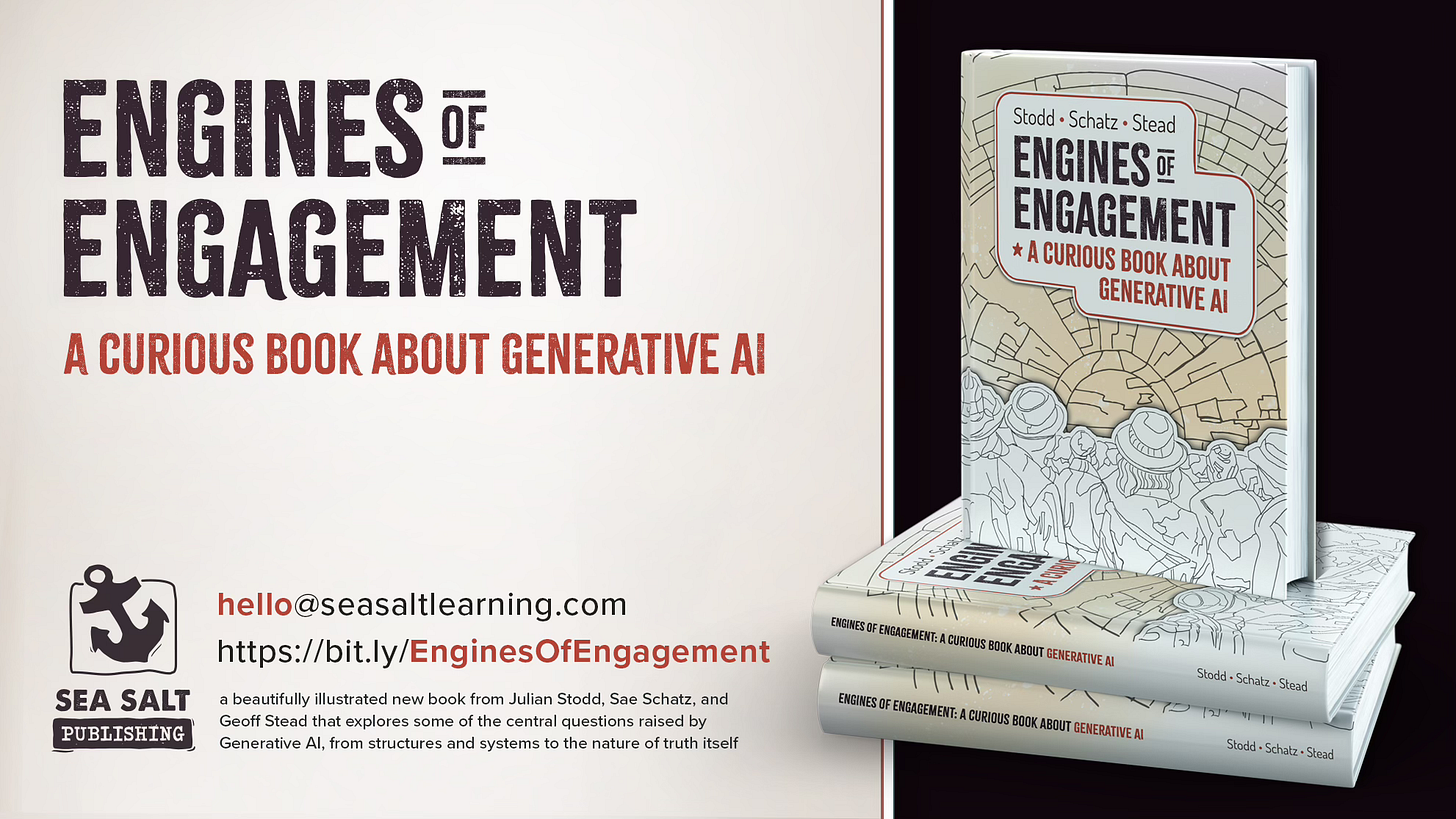‘Engines of Engagement: a curious book about Generative AI’ was published a year ago, and my thinking has continued to evolve since then, aided by the many opportunities I’ve had to share that work into diverse contexts
.Today, my primary focus is on the Social Context of AI: how it fits into our systems of productivity and effect, and how it fractures and transforms them.
Certain of these mechanisms are clear: the dialogic nature of the technology, the way it relates to our innate structures of conception, curiosity, and learning, and radically amplifies some of them (through contextualisation, rapid iteration, visualisation, synchronous and ‘human like’ feedback etc.
Also, certain disruptive features: challenges to artistry, creativity, truth and trust, identity and belief, even to notions of ‘completion’ and our overall systems of value. And certain responses are clear: that of human exceptionalism and our tendency to be satisfied with a primary diagnostic position, not an evolving one.
I am trying to weave all of this into my broader work on the context of the Social Age: to explore GenAI fully within an evolved Social Context, and as itself challenging and changing that context.
More broadly, the Social Age has favoured models of asymmetric disruption, as we see in Fintech, and my suspicion is that this trend will continue, and be amplified, by AI.
Indeed, more broadly I am exploring almost all the impacts of AI within this broader context, which I have found more valuable. Primarily to take a stance that the technology can only be appreciated within it’s context of application, and that the impacts are not only founded in features and systems, but also in stories and belief. In this sense - and to use rather odd language - GenAI is a technology of hope, for some.
It continues a pattern of the democratisation of technology, the creation of diverse and fluid ecosystems, and amplifies the already prevalent feature of the ‘Infrastructure Light’ or even ‘Infrastructure Free’ Organisation - and in this sense loops me back around to the core work on the Socially Dynamic Organisation, where I argue that we are on the brink of the truly post industrial Organisation. Maybe this will be the mid term legacy of GenAI, that it tips us into the realisation of this model, at scale.
All this leaves me with a sense, and stance, that GenAI will be more disruptive than many Organisations are planning for, but that the nature of this disruption is as yet not fully clear. In this, it may be that our certainty, and current narratives, occlude what we truly need to learn.
The narrative is largely politicised, and tips unhelpfully into simple definitions of ‘good’ and ‘bad’, when there may be a more nuanced perspective that would help us more.
In the book we considered the two main use cases: efficiency within the known systems, and innovation of the new system. Today, my sense is that the half life of efficiency is shorter than anticipated. I think that cost pressure on services is already downward, as the anticipation of efficiencies bites into legacy margins. In this sense, it’s a zero sum game, in that overall market value is driven down, but without any clear - or long term - investor benefit. In this sense, it’s hygienic, to remain in the market, but it’s not differentiating.
Or to put it another way, efficiency simply keeps you in the game: the serious investment must be in the re-imagination of the Organisation, and all our structure of productivity and effect.
My thinking continues to evolve, and now I’ve launched the new Strategic AI workshops, which will be my first opportunities to pull this into that broader context of the Social Age, so I anticipate further changes to come.
Which is as it should be: to find our certainty, during times of change, too early, is a false comfort.



